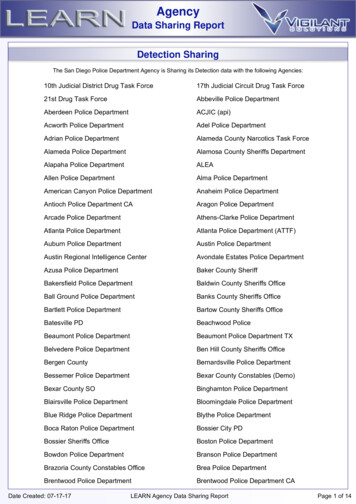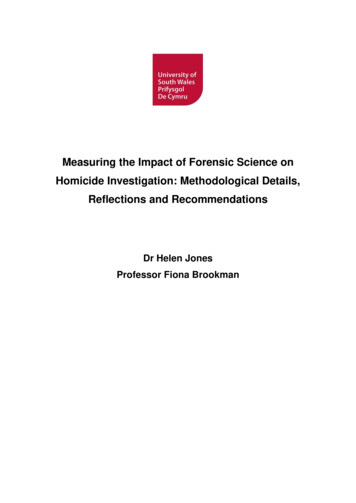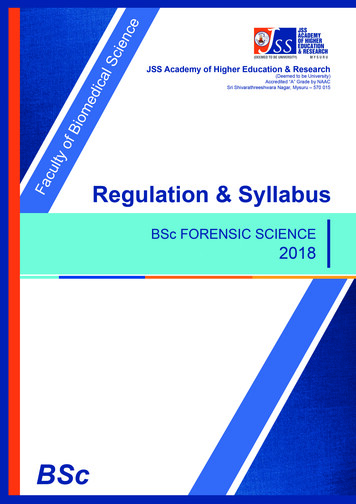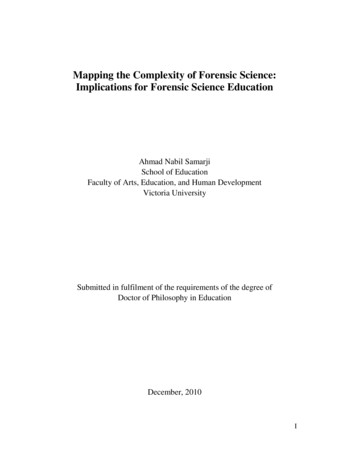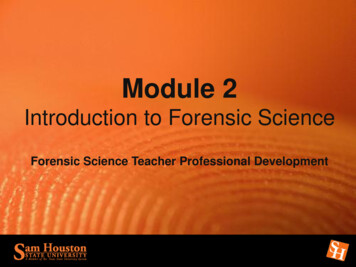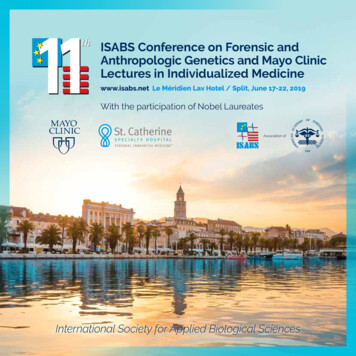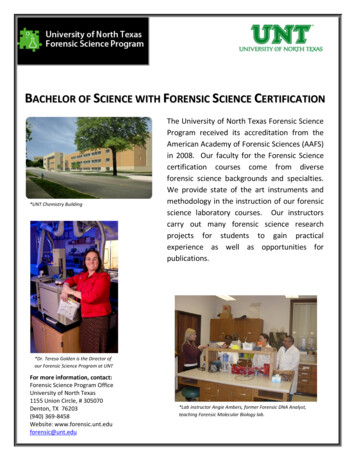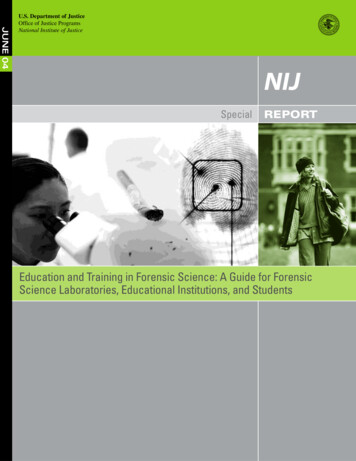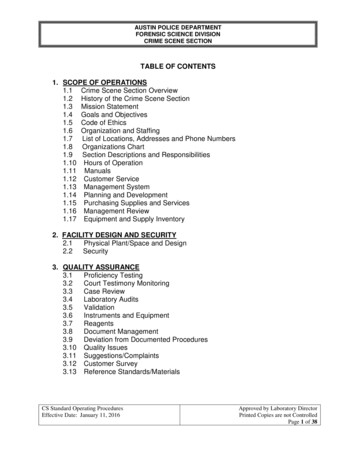
Transcription
AUSTIN POLICE DEPARTMENTFORENSIC SCIENCE DIVISIONCRIME SCENE SECTIONTABLE OF CONTENTS1. SCOPE OF OPERATIONS1.1 Crime Scene Section Overview1.2 History of the Crime Scene Section1.3 Mission Statement1.4 Goals and Objectives1.5 Code of Ethics1.6 Organization and Staffing1.7 List of Locations, Addresses and Phone Numbers1.8 Organizations Chart1.9 Section Descriptions and Responsibilities1.10 Hours of Operation1.11 Manuals1.12 Customer Service1.13 Management System1.14 Planning and Development1.15 Purchasing Supplies and Services1.16 Management Review1.17 Equipment and Supply Inventory2. FACILITY DESIGN AND SECURITY2.1Physical Plant/Space and Design2.2Security3. QUALITY ASSURANCE3.1Proficiency Testing3.2Court Testimony Monitoring3.3Case Review3.4Laboratory Audits3.5Validation3.6Instruments and Equipment3.7Reagents3.8Document Management3.9Deviation from Documented Procedures3.10 Quality Issues3.11 Suggestions/Complaints3.12 Customer Survey3.13 Reference Standards/MaterialsCS Standard Operating ProceduresEffective Date: January 11, 2016Approved by Laboratory DirectorPrinted Copies are not ControlledPage 1 of 38
AUSTIN POLICE DEPARTMENTFORENSIC SCIENCE DIVISIONCRIME SCENE SECTION3.143.153.16Reference Collections and DatabasesExamination VerificationContamination Detection and Prevention4. LABORATORY RECORDS4.1Case Record4.2Laboratory Reports4.3Release of Records Information4.3.1 Release of Information4.3.2 Release of Information to the News Media4.3.3 Open Records Request4.3.4 Discovery Orders4.3.5 Requests for Reports4.4Removal of Records for Court4.5Archiving Laboratory Case Files4.6Expunctions4.7 Control of Laboratory Records5. EVIDENCE PROCEDURES5.1General Practices5.2Observation by Outside Experts5.3Evidence Disposal5.4Destruction of Hazardous Substances5.5Outsourcing6. SAFETY7. PERSONNEL7.1Documents7.2Subpoenas7.3Private Case Consultations7.4Testimony for Previous Employers7.5Attendance7.6Certification of Analysts7.7Employee Training Program7.8Employee Approval for Casework7.9Employee Career Development7.10 Continuing Education7.11 Internship Program7.12 Volunteer Program7.13 Rider ProgramCS Standard Operating ProceduresEffective Date: January 11, 2016Approved by Laboratory DirectorPrinted Copies are not ControlledPage 2 of 38
AUSTIN POLICE DEPARTMENTFORENSIC SCIENCE DIVISIONCRIME SCENE SECTION8. COMPUTER RESOURCE MANAGEMENT9. FORMS CS01CS02CS03CS04CS05CS06Daily WorksheetVacantVehicle Processing Facility Check-In LogVacantForensic Entomology Data FormReagent Quality Control LogCS Standard Operating ProceduresEffective Date: January 11, 2016Approved by Laboratory DirectorPrinted Copies are not ControlledPage 3 of 38
AUSTIN POLICE DEPARTMENTFORENSIC SCIENCE DIVISIONCRIME SCENE SECTION1SCOPE OF OPERATIONS1.1Crime Scene Section OverviewThe Crime Scene Section will follow the guidelines set forth in the Forensic ScienceDivision Standard Operating Procedure (SOP) Manual. Supplemental requirementsspecific to the Crime Scene Section are contained within the Crime Scene Section SOP,the Crime Scene Section Technical Manual, and the Crime Scene Section TrainingManual. These manuals combined include guidelines for the Quality System within theCrime Scene Section laboratory.This document specifies procedures and analyses relating to the recognition,documentation, collection, processing and preservation of evidence from both crimescene investigations and requests from law enforcement entities. Within the scope ofthat purpose, it is intended to ensure effective and efficient use of both the laboratoryfacilities and all equipment used during field investigations for the benefit of lawenforcement entities and with the ultimate goal of detection, solution, and prevention ofcrime.It is not possible to anticipate every situation that may arise or to prescribe a specificcourse of action for every case. The analyst must exercise good judgment based onexperience and common sense, especially when processing evidence. In some cases,the manual offers guidelines for analysis that must be tempered with the experience ofthe analyst. However, any portion of a procedure not explicitly qualified as a guideline,e.g., by the use of the word “should”, may not be modified for use in casework withoutprior approval by the Technical Leader or supervisor.1.2History of the Crime Scene SectionThe Identification Section of the Austin Police Department originated in 1924. One unitof the Identification Section became the Crime Scene Unit. The Crime Scene Unit wascreated to provide assistance to officers at crime scenes in the collection, processingand preservation of evidence; providing for the secure and safe storage of evidence andprocessing evidence for latent prints in a laboratory setting.Property CrimeTechnicians were added in 1999 to assist in the response to property crime calls bytaking reports from citizens and processing crime scenes for evidence, lessening theneed for officer response. The Crime Scene Unit became the Crime Scene Section in2004.1.3Mission StatementNo Supplemental RequirementsCS Standard Operating ProceduresEffective Date: January 11, 2016Approved by Laboratory DirectorPrinted Copies are not ControlledPage 4 of 38
AUSTIN POLICE DEPARTMENTFORENSIC SCIENCE DIVISIONCRIME SCENE SECTION1.4Goals and ObjectivesNo Supplemental Requirements1.5Code of EthicsNo Supplemental Requirements1.6Organization and StaffingNo Supplemental Requirements1.7List of Locations, Addresses and Phone NumbersNo Supplemental Requirements1.8Organizational ChartNo Supplemental Requirements1.9Section Descriptions and ResponsibilitiesNo Supplemental Requirements1.10 Hours of OperationThe Crime Scene Section maintains 24 hour coverage every day for major crimescenes. The coverage is divided into the following three shifts: Day shift: Evening shift: Night shift:0600 to 1400 hours1400 to 2200 hours2200 to 0600 hours Section employees rotate days off every 28 days. Management will attempt tomaintain a shift rotation that covers a six month period. Switching or trading of workhours between employees is not permitted. Management may alter shift schedulesdepending on the needs of the section. Shift preference will be determined by seniority. A shift bid roster will be passedaround in order of seniority and each employee will select a preferred open slot. Thefollowing criteria will be used in descending order to determine seniority in the CrimeScene Section:CS Standard Operating ProceduresEffective Date: January 11, 2016Approved by Laboratory DirectorPrinted Copies are not ControlledPage 5 of 38
AUSTIN POLICE DEPARTMENTFORENSIC SCIENCE DIVISIONCRIME SCENE SECTION Time in current position/promotion start date. Previous position/promotion start date. Employment start date with Forensics Science Division per Human Resourcesdate/time stamp on employee’s application. Employments start date with the City of Austin. Banner number by ascending order (smallest number equals highest seniority). Seniority criteria for shift assignments apply only to personnel employed in the CrimeScene Section for one year or more. Shift assignments for personnel employed inthe Crime Scene Section for less than one year may be determined by managementdiscretion. Additionally, management may make exceptions to the above senioritylist depending on the needs of the section. Previous position/promotion start datesprior to an employee’s last two positions are not used as criteria for seniority. A callback roster is utilized for the availability of additional personnel on major crimescenes or as necessary as determined by a supervisor. In the event that additionalpersonnel are needed beyond the initial call out, those personnel will be contactedvia pager and advised to respond for assignment. During bad weather episodes asdeemed by the city manager, all essential personnel scheduled to be on duty mustreport to work regardless of their current work assignment (e.g., training, laboratoryduty, court, etc.). Crime Scene Supervisors A Crime Scene Supervisor is assigned to each shift and one supervisor isresponsible for the Quality Assurance of the Section and the Crime SceneLaboratory. The supervisors rotate days off every 28 days. One supervisor is oncall 24 hours a day, for one week, rotating every four weeks. Crime Scene Specialists Four Crime Scene Specialists are assigned to each eight-hour shift. One CrimeScene Specialist is assigned to a day shift in the laboratory. In addition toworking a scheduled shift, one Crime Scene Specialist is on call for a rotatingone-week period in the event additional personnel are needed. On-callpersonnel have a maximum of one hour to respond to the scene when not onduty. Callback must be approved by a supervisor prior to response.CS Standard Operating ProceduresEffective Date: January 11, 2016Approved by Laboratory DirectorPrinted Copies are not ControlledPage 6 of 38
AUSTIN POLICE DEPARTMENTFORENSIC SCIENCE DIVISIONCRIME SCENE SECTION Property Crime Technicians Seven Property Crime Technicians are assigned to the day shift and seven areassigned to the evening shift. There is no established on-call schedule forProperty Crime Technicians; however, supervisors can initiate a page to thetechnicians for assistance, depending on the needs of the section.1.11ManualsNo Supplemental Requirements1.12Customer ServiceNo Supplemental Requirements1.13Management System Crime Scene Supervisor The Crime Scene Supervisor is responsible for coordinating and supervising thedaily activities of personnel within the Crime Scene Section (CS), to include theprocessing of evidence, ordering of supplies and equipment, and maintaining theCS Laboratory. Supervisors are responsible for responding to major crime sceneinvestigations, as needed, and are responsible for assuming supervisory controlof CS personnel, making decisions on the processing of the crime scene,providing liaison between CS personnel and investigators/communications/officers, ensuring the safety and security of CS personnel and evidence whileprocessing the scene, ensuring CS personnel use appropriate personalprotective equipment, ensuring that sufficient supplies, equipment, and personnelare available, including any additional personnel needed for secondary crimescenes or assignments, notifying the chain of command, and providing periodicupdates as needed. Senior Crime Scene Specialist Senior Crime Scene Specialists work under the direction of a Crime SceneSupervisor. They respond to major crime scenes, following standardizedprinciples, practices, and procedures in the evaluation, documentation, collection,preservation, processing, and/or handling of evidence at/from major scenes. Senior Crime Scene Specialists will respond to certain property crime sceneswhen no Property Crime Technician is available, including those that:o involve DNA and/or impression evidence collection;o are designated by investigators – as a serial episode;o involving APD or regarded as high profile in nature.CS Standard Operating ProceduresEffective Date: January 11, 2016Approved by Laboratory DirectorPrinted Copies are not ControlledPage 7 of 38
AUSTIN POLICE DEPARTMENTFORENSIC SCIENCE DIVISIONCRIME SCENE SECTION Senior Crime Scene Specialists are responsible for completing a professionalreport and providing expert testimony in court. Other assigned duties may includeprocessing of pending laboratory requests, peer review of reports, and thecoordination and communication of shift activities during supervisor absence.They are expected to provide training, guidance, and technical support to sectionpersonnel. Senior Crime Scene Specialists must complete and maintain therequired certification as mandated in the job description – unless exempt asbeing “grandfathered”. Senior Crime Scene Specialists acquire this designation through the DivisionProgression Plan. Crime Scene Specialist Crime Scene Specialists work under the direction of a Crime Scene Supervisor.They respond to major crime scenes, following standardized principles, practices,and procedures in the evaluation, documentation, collection, preservation,processing, and/or handling of evidence at/from major crime scenes. Crime Scene Specialists will respond to certain property crime scenes when noProperty Crime Technician is available, including those that:o involve DNA and/or impression evidence collection;o are designated by investigators – as a serial episode;o involving APD or regarded as high profile in nature. Crime Scene Specialists are responsible for completing a professional report andproviding expert testimony in court. Other assigned duties may includeprocessing of pending laboratory requests, peer review of reports, and otherduties as needed. Crime Scene Specialists are also responsible for thecoordination and communication of shift activities in the absence of a supervisoror Senior Crime Scene Specialist. Crime Scene Specialists must complete andmaintain the required certification as mandated in the job description. Senior Property Crime Technician Senior Property Crime Technicians work under the direction of a Crime SceneSupervisor. They respond to property crime scenes, following standardizedprinciples, practices, and procedures in the evaluation, documentation, collection,preservation, processing, and/or handling of evidence at/from property crimescenes. Senior Property Crime Technicians are also responsible for completing aprofessional analysis report and providing expert testimony in court. Otherassigned duties may include processing of pending laboratory requests,CS Standard Operating ProceduresEffective Date: January 11, 2016Approved by Laboratory DirectorPrinted Copies are not ControlledPage 8 of 38
AUSTIN POLICE DEPARTMENTFORENSIC SCIENCE DIVISIONCRIME SCENE SECTIONadministrative peer review of reports, and other duties as needed. SeniorProperty Crime Technicians must complete and maintain the requiredcertification as mandated in the job description. They are not responsible for handling all property crime calls within the city.Patrol officers are still responsible for responding to calls that cannot be handledin a timely manner by section personnel. Senior Property Crime Technicians arenot to be utilized as an evidence transport unit for the Department. Only evidencerequiring forensic examination should be transported. Senior Property Crime Technicians acquire this designation through the DivisionProgression Plan. Property Crime Technician Property Crime Technicians work under the direction of a Crime Scene SectionSupervisor. They respond to property crime scenes, following standardizedprinciples, practices, and procedures in the evaluation, documentation, collection,preservation, processing, and/or handling of evidence at/from property crimescenes. Property Crime Technicians are also responsible for completing aprofessional analysis report and to providing expert testimony in court. Otherassigned duties may include processing of pending laboratory requests,administrative peer review of reports, and other duties as needed. They are not responsible for handling all property crime calls within the city.Patrol officers are still responsible for responding to calls that cannot be handledin a timely manner by section personnel. Property Crime Technicians are not tobe utilized as an evidence transport unit for the Department. Only evidencerequiring forensic examination should be transported.1.14 Planning and DevelopmentStatistical Information and Reports Statistical reports are utilized to assist in tracking workload, predicting increasesin workflow, and preparing staffing or budget analysis. Each section employee isresponsible for documenting their daily activity for the purposes of statisticalanalysis. Supervisors or designees are responsible for ensuring that theinformation is being documented. Acceptable Reporting Methods LIMS CS – Crime Scene Investigation Information panel LIMS CSL – Crime Scene Laboratory Information panel LIMS Activity Log (on main page) Crime Scene Section Daily Worksheet ResponsibilitiesCS Standard Operating ProceduresEffective Date: January 11, 2016Approved by Laboratory DirectorPrinted Copies are not ControlledPage 9 of 38
AUSTIN POLICE DEPARTMENTFORENSIC SCIENCE DIVISIONCRIME SCENE SECTION Employees’ Responsibilitieso Employees may document their daily activity utilizing the LIMS CS/CSLInformation Panels or LIMS Activity Log and the Crime Scene SectionDaily Worksheet, as applicable. This applies whether the employee isworking a full or partial shift, or attending court on a scheduled day off.o Employees should ensure all applicable fields are complete and accurateand that all non-analysis/assignment activities are documented as soon aspractical.o The statistical information regarding assignments, specifically the DailyWorksheet, should be completed by the end of the shift and routed to theappropriate Supervisor for review. Procedures LIMS CS – Crime Scene Investigation Information panel is located in theReport Writing section of each LIMS CS assignment. This panel will be usedto document analysis activities performed and statistical information related toa specific field case. The following are the call codes denoted in the “Scene Type” section for eachLIMS CS field assignment:o Field Call: Used on all calls for service in which non-laboratory workproduct is initiated or expected. This would include collecting a samplefrom a suspect at the jail, responding to the Main to collect clothing from adetective, etc.o Canceled: Used after responding to calls for service for at least fiveminutes and then canceled or preempted.o Morgue Call: Used to account for time attending actual autopsies. The“Photo Only” code should not be used.o No Action Call: Used after arriving on scene and determining that no crimescene processing is needed.o Photos Only Call: Used on those calls for service in which onlyphotography/video documentation is completed. No processing isperformed and no items of evidence are collected. An example would bephotos of victim injuries with no further action taken.o Others: Used to account for time spent related to a specific offensenumber performing Crime Scene duties not listed above. The remaining sections of the Investigation Information panel will becompleted for each LIMS CS field assignment worked.CS Standard Operating ProceduresEffective Date: January 11, 2016Approved by Laboratory DirectorPrinted Copies are not ControlledPage 10 of 38
AUSTIN POLICE DEPARTMENTFORENSIC SCIENCE DIVISIONCRIME SCENE SECTIONo “Additional Minutes” – will be determined as the amount of time required tofully complete an assignment after departing the scene, includingpackaging, data entry, submission and report writing.o “# Items Collected” – will be determined as those items packagedseparately, including items later separated before submission to the CEL. LIMS CSL – Crime Scene Laboratory Information panel is located in theReport Writing section of each LIMS CSL assignment. This panel will beused to document analysis activities performed and statistical informationrelated to a specific lab case.o “Total Time” – determined as the amount of time required to fully completea lab assignment, including all analysis, packaging and report writing.Time will be denoted in minutes only (not hours).o “# Items Processed for DNA” – determined as those items that requiredsample(s) be collected for a DNA Lab Request.o “# Items Processed for LP” – determined as those items that are actuallyprocessed for latent prints. One pistol (e.g. with ten rounds and amagazine) to be processed will equal twelve items.o “# of Friction Ridge Photos” – determined as those photos that will betransferred to a CD for Latent Print Section comparisons.o “# Latent Cards” – will include all friction ridge lifts and casts.o “# Photo only items” – determined as non-friction ridge items that arephotographed in the lab, (i.e., damage to clothing, stains, etc.) LIMS Activity Log: Call codes for the LIMS Activity Log, to be used for anynon-analysis type of assignment performed by employees of the Crime SceneSection, are as follows:o COURT: Used for pretrial meetings and court testimony.o CSVIN: Crime Scene Daily Vehicle Inspectiono MAINT: Used for vehicle repair, calibration of equipment, preventativemaintenance type duties.o PRACT: Used for public relations activities, such as lectures, tours,science fairs, community groups, etc.o PRES: Used for training given as an instructor or presenter.o TRAIN: Used when training is received as a student. Crime Scene Section Daily Worksheet will be used to document andsummarize daily activities of field personnel. The employee will total theCS Standard Operating ProceduresEffective Date: January 11, 2016Approved by Laboratory DirectorPrinted Copies are not ControlledPage 11 of 38
AUSTIN POLICE DEPARTMENTFORENSIC SCIENCE DIVISIONCRIME SCENE SECTIONnumber of Field, Lab, Report, and Miscellaneous cases worked during theirshift on each day in the appropriate box under “Number of Cases Worked”.Additionally, the following information will be documented daily on thisworksheet:o CODE:a. “F”: Field – any field crime scene call including morgue, photo only, noaction, and cancelledb. “L”: Lab – any casework performed in the laboratoryc. “R”: Report – report written on field or lab workd. “M”: Miscellaneous – any Crime Scene duties/activities not listedaboveo ACTIVITY:a. The title of offense or description of duty/activity performedo LIMS and/or CASE#:a. The LIMS and/or case number related to field or lab worko TIME USED:a. The total amount of time used to work on a certain case or duty/activity1.15Purchasing Supplies and ServicesNo Supplemental Requirements1.16Management Review SystemNo Supplemental Requirements1.17 Equipment and Supply InventoryThe Crime Scene (CS) Section has one person assigned to the Crime SceneLaboratory. This person is responsible for ensuring that proper supplies areavailable in the laboratory. Even though this person is primarily responsible forthese functions, it is the responsibility of every employee to report inadequate supplylevels and malfunctioning equipment to a Crime Scene Supervisor. Chemical Supplies It is the responsibility of the supervisors to ensure that a monthly chemicalinventory is conducted to ensure that an adequate supply is maintained.CS Standard Operating ProceduresEffective Date: January 11, 2016Approved by Laboratory DirectorPrinted Copies are not ControlledPage 12 of 38
AUSTIN POLICE DEPARTMENTFORENSIC SCIENCE DIVISIONCRIME SCENE SECTION The person conducting the inventory will forward the results of the inventoryto a supervisor. Supervisors are responsible for ensuring that purchase requests are preparedand chemicals are re-stocked in a timely manner. Laboratory and Field Supplies It is the responsibility of the supervisors to ensure that a monthly supplyinventory is conducted to ensure that an adequate supply is maintained. The person conducting the inventory will forward the results of the inventoryto a supervisor. Supervisors are responsible for ensuring that purchase requests are preparedand supplies are re-stocked in a timely manner. It is the responsibility of section personnel to ensure that the lab and vehiclesare properly stocked to perform the functions assigned to the section.2FACILITY DESIGN AND SECURITY2.1Physical Plant/Space and DesignNo Supplemental Requirements2.2Security The section maintains the following storage locations within the Crime SceneLaboratory (ASCLD/LAB 5.3.4.1.f and ASCLD/LAB 5.8.4.2): In-Process Storage Temporary Storage Cabinets Two Evidence Storage Rooms (or Vault) are located in the operational area ofthe section. One room contains individually secured evidence cabinets withkeys. A key will be kept in each lock when not in use. When an item ofevidence is placed in an evidence cabinet, the employee will remove the keyand maintain custody of the key until the evidence is removed. The key willthen be placed back in the lock for future use. Refrigeration Storage Bins The second Evidence Storage Room contains the Evidence Refrigerator – inwhich are two individually secured storage bins. A key is kept in each lockwhen not in use. When an item of evidence is placed in a bin, the employeeCS Standard Operating ProceduresEffective Date: January 11, 2016Approved by Laboratory DirectorPrinted Copies are not ControlledPage 13 of 38
AUSTIN POLICE DEPARTMENTFORENSIC SCIENCE DIVISIONCRIME SCENE SECTIONwill remove the key and maintain custody of the key until the evidence isremoved. After use, the key will be placed back in the lock. Drying Rooms Individually secured Evidence Drying Rooms are located in the operationalarea of the section. A key will be kept in each door lock when not in use.When an item of evidence is placed in a drying room, the employee willremove the key and maintain custody of the key until the evidence isremoved. The key will then be placed back in the lock for future use. A supervisor will be notified no later than 24 hours when any key is unaccountedfor and immediately if the integrity of the evidence is at risk. Long Term (Bulk) Storage Evidence Storage Rooms Two Evidence Storage Rooms (or Vault) are located within the operationalarea of the section and are utilized for the storage of bulk evidence andevidence pending processing. The refrigerator is located within the second Evidence Storage Room and isutilized for the storage of bulk refrigerated evidence and evidence pendingprocessing. Both evidence storage rooms are secured with punch code combination locksand are locked when the lab is unattended. (ASCLD/LAB 5.8.4.1) Only section personnel are issued the 4-digit generic security punch code. South Congress Vehicle Processing Facility Security Keys for the pedestrian door of the facility are attached to each vehicle keyring or are accessible to approved personnel. The vehicle key rings are storedwithin the secured Crime Scene Squad Room when not in use. Approved personnel are issued a personal 4-digit security code to activateand de-activate the alarm system. This code will not be disclosed to anyone. Once entry into the facility is made, a 60 second delay of the alarm is given toallow deactivation of the system by entering the four digit code on the keypad. In the event the code is not entered in a 60 second period, the system willactivate and the security company will be notified immediately of the alarm. The company will call the facility and request the password, which has beenprovided to each approved employee. The correct password will terminate thealarm. An incorrect password will initiate a police response to the facility.CS Standard Operating ProceduresEffective Date: January 11, 2016Approved by Laboratory DirectorPrinted Copies are not ControlledPage 14 of 38
AUSTIN POLICE DEPARTMENTFORENSIC SCIENCE DIVISIONCRIME SCENE SECTION Prior to exiting the facility, the system must be rearmed by entering the fourdigit personal code.The doors will be secured and the security system activated whenunoccupied.In the event that the personal code is forgotten, approved personnel maycontact a Crime Scene Supervisor to obtain their personal code.A monthly printout, establishing each time the system is armed and disarmed,is received and maintained by the Crime Scene Supervisors.Anyone not issued a personal security code will be accompanied by approvedstaff and use the Visitor Log (FSD-04) when accessing the facility. Springdale Vehicle Processing Facility Access to the processing bay of the facility is via card access. Card accessto the facility is approved by the Laboratory Director. Anyone not issued card access will be accompanied by approved staff andwill utilize the Visitor Log (FSD-04) when accessing the facility.3QUALITY ASSURANCE3.1Proficiency Testing Frequency of Testing Each Crime Scene Section analyst will participate in and successfullycomplete an internal proficiency test every calendar year, unless the analysthas performed an external proficiency test during the same period. Ifunavailable, the analyst will be administered the internal proficiency testupon return to duty. (ASCLD/LAB 5.9.3.4) The proficiency test will be developed by the Technical Leader and willconsist of the applicable instructions, description of its preparation with anyitems and the expected outcomes. A CS supervisor will develop a different test for the Technical Leader. The proficiency tests will be constructed from the various duties required forcrime scene investigations and latent print processing. (ASCLD/LAB 5.9.3.3) The proficiency test will be performed by the supervisors prior to personneldissemination. The proficiency test and applicable instructions will be forwarded to thesupervisor(s) or designee who will:a) Enter the test information in LIMS, initiate the Proficiency Review Form(QA 01), and request the Quality Assurance Manager to lock the LIMScases prior to conducting the test.b) Schedule the proficiency tests and evaluate the employee performance.CS Standard Operating ProceduresEffective Date: January 11, 2016Approved by Laboratory DirectorPrinted Copies are not ControlledPage 15 of 38
AUSTIN POLICE DEPARTMENTFORENSIC SCIENCE DIVISIONCRIME SCENE SECTION 3.2c) Return the completed test and all paperwork for each employee to theTechnical Reviewer.The Technical Reviewer will evaluate each test with the supervisor orevaluator to determine if and what level any nonconformancies wasdetected.The Technical Reviewer with the supervisor will determine what actions,such as remedial training, removal from casework, etc., will be required forany nonconformity.The analyst will be informed of the results before signing the ProficiencyReview Form.The Proficiency Review Form will be forwarded to the Quality AssuranceManager after completion and subsequently returned to the s
CS Standard Operating Procedures Effective Date: January 11, 2016 Approved by Laboratory Director Printed Copies are not Controlled Page 1 of 38 TABLE OF CONTENTS . 1. SCOPE OF OPERATIONS 1.1 Crime Scene Section Overview 1.2 History of the Crime Scene Section 1.3 Mission Statement 1.4 Goals and Objectives 1.5 Code of Ethics
